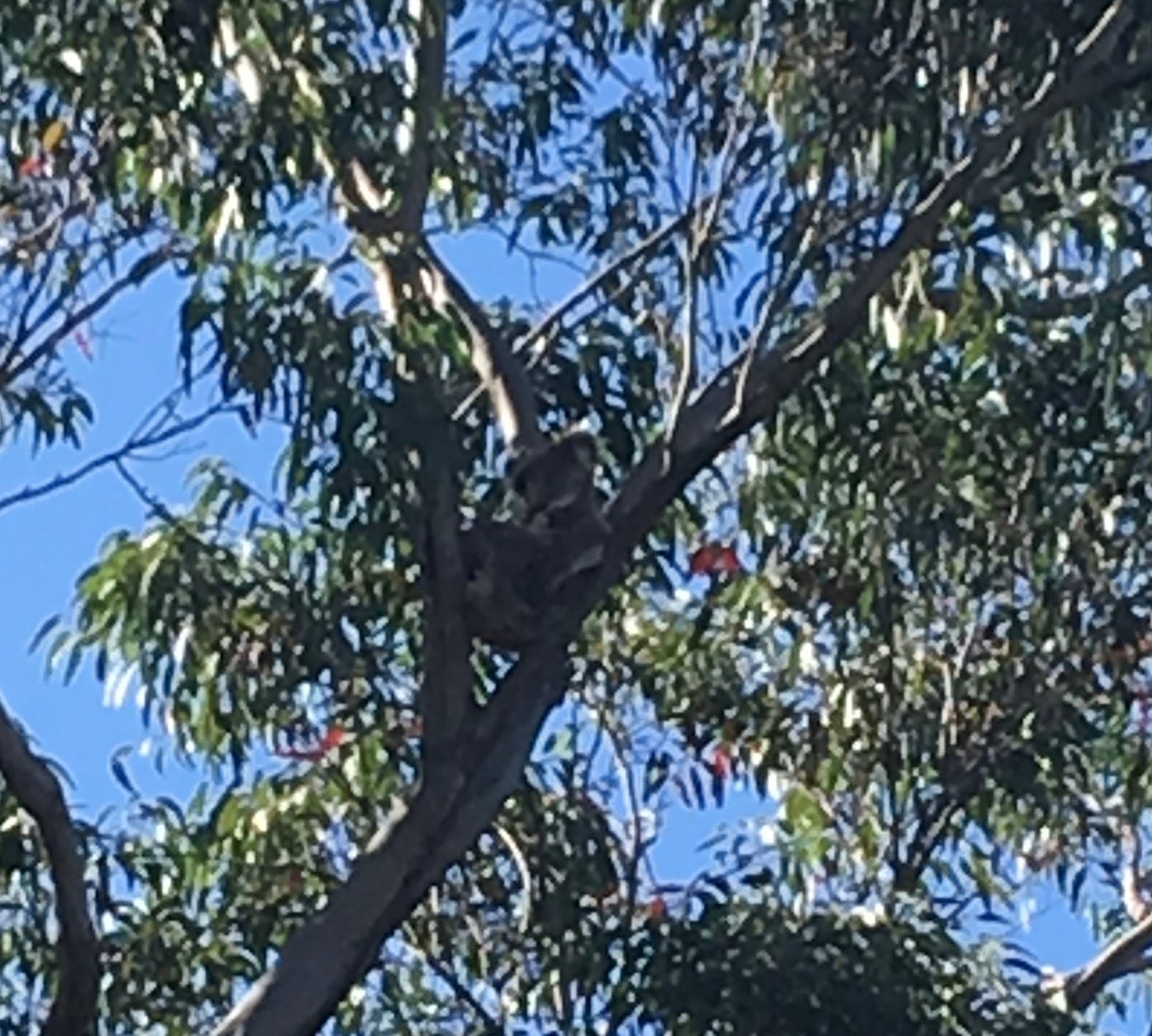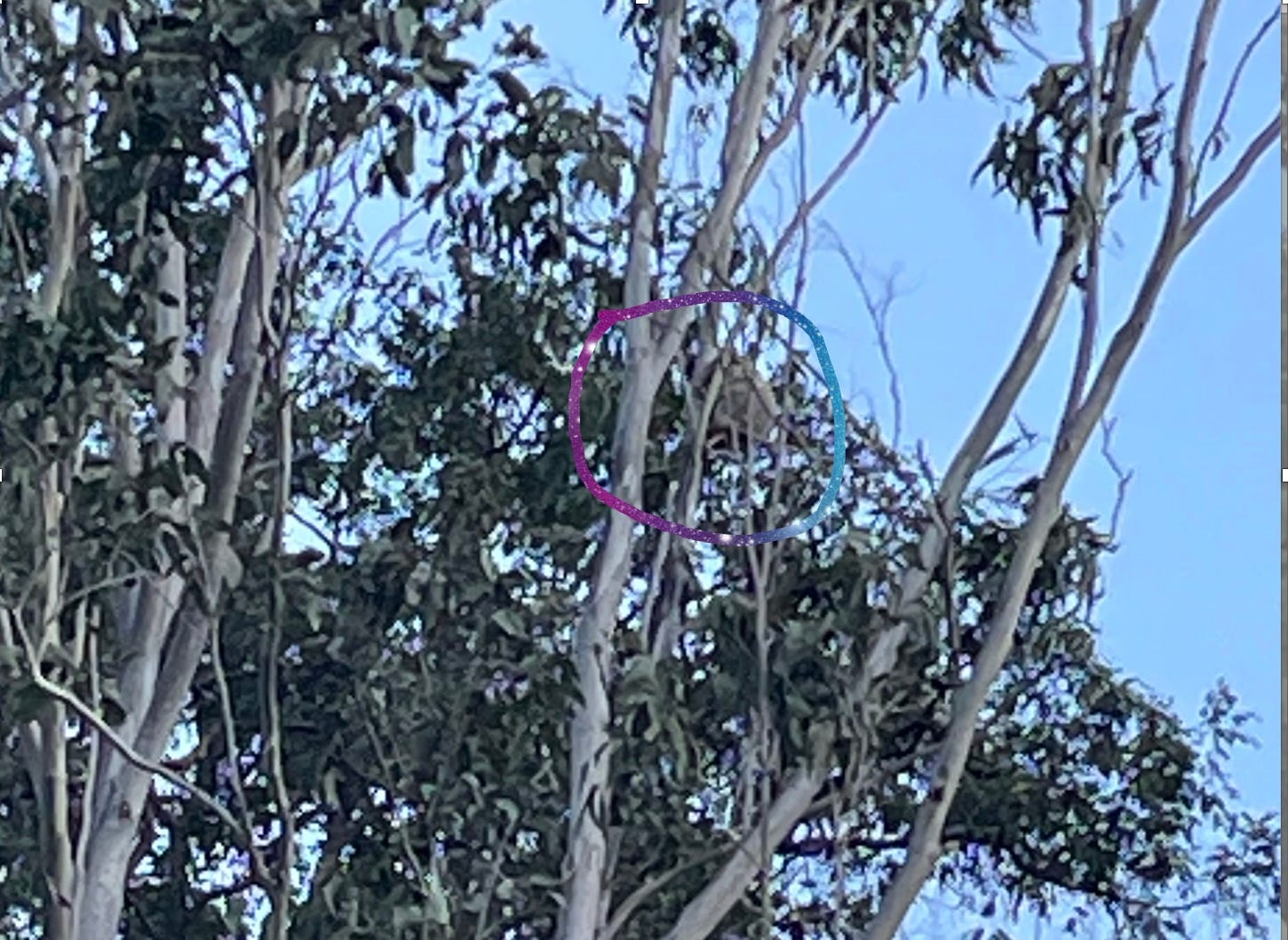Food is bliss!
Spotting koalas: a reminder to look up!
We don’t often see koalas here at Kawalang but know that they are around. Grunting sounds that koalas make when mating are outstanding and unmistakable. Koalas are tree dwelling, leaf-eating marsupials, with their closest relatives being wombats, an Australian native animal that looks a bit like an oversized groundhog. Keith wrote about wombats in our last Substack.
A few years ago, a friend visiting saw a koala high up in the tree near our big shed. It must have found a more comfortable place later that day to munch its favourite eucalyptus leaves and sleep, as it moved on when the wind picked up and most likely headed deeper into the bush. We have to be reminded to look up to see if one is about, though one is meant also to look for its poo, or scat, to give a clue about what is up the tree.
A koala perched in a gum tree just near our shed.
Happy Birthday, neighbour!
Koalas are an endangered species in New South Wales, Queensland and the Australian Capital Territory. Habitats are destroyed by bushfires as well as land clearing for housing, industry or farming. When habitat is destroyed, koalas have to travel to find food; every moment on the ground is dangerous, as cars and trucks hit wildlife crossing the road and attacks by dogs are common. Koalas were hunted for furs when early settlers arrived, which nearly led them to extinction in some areas.
At our neighbour’s 90th birthday party, a koala appeared to pay respects, not too high up the tree, just high enough to be visible and admired. As our neighbour and her husband were long-timers, having built their home there forty years ago, it is not surprising that a koala joined the celebration.
Birthday greetings!
Significant creatures, conflicting strategies
Sleeping as much as twenty hours a day while digesting highly toxic leaves, koalas can be vicious when disturbed, with claws strong enough to dig into tree bark. With their divine faces, huge eyes and furry ears, they are also a symbol of something special. Significant to Aboriginal communities and culture across Australia particularly here in the Hunter region, koalas represent ancestral connections, are seen as totemic animals and are an integral part of spiritual beliefs and Dreamtime stories. A number of wildlife protection groups are currently mapping koala habitats so that their grazing areas can be protected. Documenting areas that are known to be wildlife or koala corridors may still not make them safe, but it is a start.
This is in stark contrast to the aerial culling of koalas in Victoria in April this year. The culling was allegedly undertaken to stop further suffering of koalas in the Budj Bim National Park in western Victoria where, in mid-March, a bushfire had burned approximately 20% of the park or about 2200 hectares (5436 acres). The park represents a ‘habitat island’, where there is an abundance of the koalas’ favourite type of gum trees. With commercial blue gum plantations that are logged surrounding the Budj Bim National Park, the koalas had nowhere to go.
In the past, when there has been an overpopulation of koalas, the Victorian Department of Energy, Environment and Climate Action (DEECA) has worked with Parks Victoria and Traditional Owners who know the landscape and where koalas hang out; working together, they have moved koalas to new locations or sterilised them. In this case, wildlife groups were not contacted immediately after the fires or prior to the cull to offer different approaches.
There are strategies that could have been employed: delivering fresh gum leaves to prevent starvation while assessing carefully which koalas weren’t going to make it and needed euthanising. Shooting koalas from helicopters thirty metres or more in the air, meant that koalas couldn’t be examined closely to determine whether their injuries were fatal or whether they were carrying joeys in their pouches. Killing an estimated 1000 koalas remotely from the air to ‘reduce suffering’ seems oxymoronic when ordered by a government department responsible for protecting biodiversity. Wildlife groups have filed a lawsuit in the Victorian Supreme Court to declare the authorisation invalid and to prevent further culling.
Tracking their travels
Considering the above, you can imagine how deeply appreciative Keith and I were when a New South Wales Local Land Services (LLS) staff member showed up at Kawalang to help us identify whether there are any koalas on our property and where koalas travel in our region. Traveling to rural properties across the Hunter region to assist landholders with detecting koalas, the staff member placed a camera in two locations deep in the bush here at Kawalang. The cameras detect movement 24/7, so we will also get a read-out of other wildlife in the area. We’ve put up a third camera to provide more coverage. The cameras will stay in place for over a year, but will be checked by us and by LLS staff from time to time. Drone surveys are also taking place over a wider region, using thermal-imaging (heat-sensors) to detect koalas and where they travel. This is a more extensive program that provides information about wildlife habitat and movement, providing a foundation for state and local policies that protect endangered species.
One of the cameras poised to take pictures of wildlife on the move.
How can we help?
Not all is rosy around koala protection. Through another NSW Government program, koalas recently were reintroduced to an area in southern NSW; seven out of the thirteen reintroduced died within a very short time, possibly from septicaemia. Back to the core question of development and logging: interrupting habitat is a slippery slope where, no matter how many strategies are out there to address the problem, maybe assessing the priority of doing the activity in the first place is needed.
What are Keith and I doing at Kawalang to support the safety and wellbeing of koalas? Looking for their scat, scanning the trees (we have many of their favourite leaves / trees), inviting others to map where koalas are and moving to, and simply, caring.
Also, we are spreading the word to you…to share with others. Species get looked after by people caring and spreading the word. Remember to look up (and look down….check the scat on the ground: it looks like green or brown chocolate covered licorice bullets!)…and tell others. Sensible policies are developed when enough people care, and speak out.
Remember me….!








